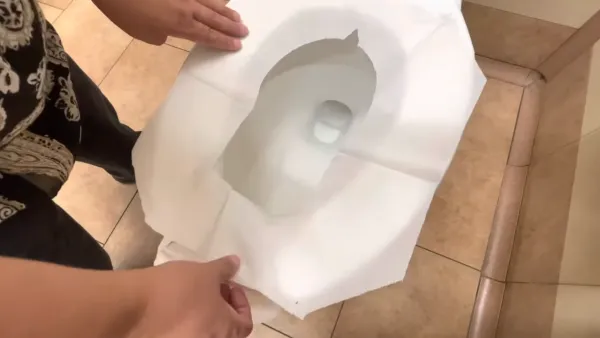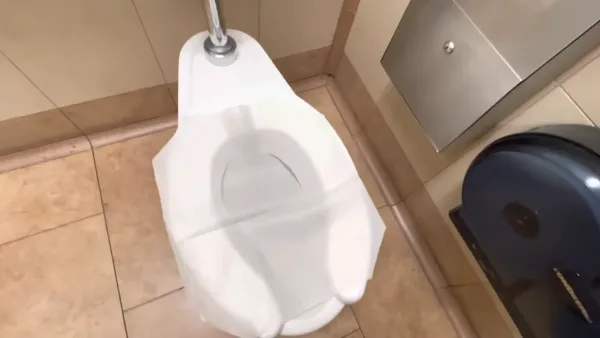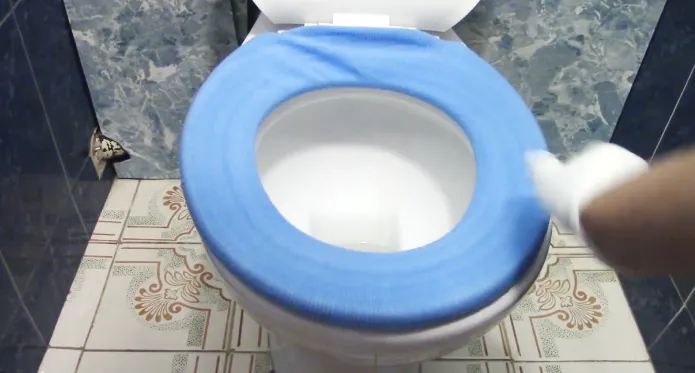Last Updated on October 17, 2023
Using a toilet seat cover can be a common practice in public restrooms to safeguard yourself against potential germs and maintain hygiene.
But have you ever wondered whether it’s safe to flush those disposable paper seat covers after use? In most cases, you can flush toilet seat covers.
Toilet seat covers, particularly the paper ones commonly found in public restrooms, are designed to be flushable.
But it’s better to throw toilet seat covers away in rural settings or areas with private septic systems rather than flush them.
We will discuss how to use and flush toilet seat covers safely to ensure cleanliness and hygiene in public restrooms.
Factors to Consider About Flushing Toilet Seat Covers

You need to consider 2 factors when deciding whether or not to flush toilet seat covers.
- Flushability of the material
- Plumbing system and toilet type
1. Flushability of the Material
One of the primary factors to consider when deciding whether to flush a toilet seat cover is the material it’s made of. Most commonly, paper toilet seat covers found in public restrooms are designed to be flushable.
They are made from materials that break down quickly in water, preventing clogs in the plumbing system.
However, decorative toilet seat covers made of materials like cotton or faux fur are non-flushable and should not be disposed of in the toilet.
So, the material composition of the seat cover is crucial in determining whether it can be flushed or not.
2. Plumbing System and Toilet Type
The type of plumbing system and the toilet itself play a significant role in whether you should flush a toilet seat cover.
In commercial bathroom settings with strong plumbing systems, flushable toilet seat covers are generally safe to use.
But, in rural areas or those with private sewage systems, it’s often recommended to dispose of seat covers in the trash can to avoid potential plumbing issues.
Older buildings, gravity-flush toilets, and septic tanks may also be more susceptible to clogs when flushing seat covers. Therefore, consider the specific plumbing and toilet systems in use.
How do you flush toilet seat covers?
Flushing toilet seat covers after use is a straightforward process. Take out a single seat cover from a toilet seat cover dispenser, usually located behind toilet stalls.
Gripping the seat cover by its edges, carefully separate it from the rest of the stack. Always ensure the flap is hanging inside the bowl by attaching it to the front of the toilet seat.
Now press the flush handle or button normally. As you do this, watch as the swirling water in the toilet bowl carries the seat cover down with it.
In most cases, the flush is strong enough to remove the seat cover completely, keeping the restroom clean and reducing harmful germs and bacteria infections.
Should the flap of the toilet seat cover hang in the front or back of the toilet seat?
The flap of the toilet seat cover should be positioned in the front of the toilet seat. To ensure proper placement, align the flap so that it falls inside the bowl and the cover’s outer ring completely covers the toilet seat.
In the vicinity of the flushing mechanism, the part of the cover where the flap is still attached should meet the front edge of the toilet.
This arrangement allows for effective coverage and ensures that the seat cover can be easily flushed away after use.
Can you reuse a toilet seat cover if it appears clean after use?
Disposable paper toilet seat covers are designed for single use only, and discarding them after each use is recommended to maintain proper hygiene.
Even though it may appear clean, there could still be unseen bacteria or germs on the surface of the cover.
Reusing it can increase the risk of contamination and potential illness. It’s important to remember that these covers are meant to be used sparingly as they are often made of thin, porous material that cannot effectively protect against pathogens.
But there are some reusable toilet seat covers available. The fabric or other material used to make reusable toilet seat covers may be reused multiple times. However, washing them thoroughly after each use is imperative to ensure they remain clean and free from bacteria.
How do you keep a washable toilet seat cover clean?
To ensure that a washable toilet seat cover remains clean, begin by removing the cover from the toilet seat.
Then, use a damp sponge or cloth with neutral soap or mild, natural standard household cleaning products to gently clean the surface of the cover.
Ensure thorough cleaning, especially in areas prone to contact. Rinse the cover thoroughly with clean water, and allow it to air dry or follow the manufacturer’s care instructions.
Are toilet seat covers bad for the environment?

Toilet seat covers can indeed have environmental implications, depending on their material composition.
While many toilet seat covers are made of paper and are generally considered safe for the environment, some variants are crafted from plastic.
Plastic toilet seat covers, although more durable and effective at protecting against germs, can pose environmental risks.
The plastic in these covers has the potential to contaminate soil and water when disposed of, as it can seep into the ground and release harmful chemicals.
To minimize the environmental impact, it’s advisable to opt for paper-based toilet seat covers rather than plastic ones if you choose to use them.
Navigate the Safe Use of Toilet Seat Covers
Flushing toilet seat covers is generally safe, especially in commercial restrooms with strong plumbing systems. However, it’s crucial to consider the seat cover’s material composition and the type of toilet system in use before flushing.
Toilet seat covers made of paper are flushable since they break down quickly in water and prevent clogs. On the other hand, cotton or faux fur toilet seat covers can’t be flushed and should go in the trash.
Always remember to position the flap of the seat cover inside the toilet bowl and wash your hands after flushing. Taking these precautions will help maintain good hygiene and prevent plumbing issues.

